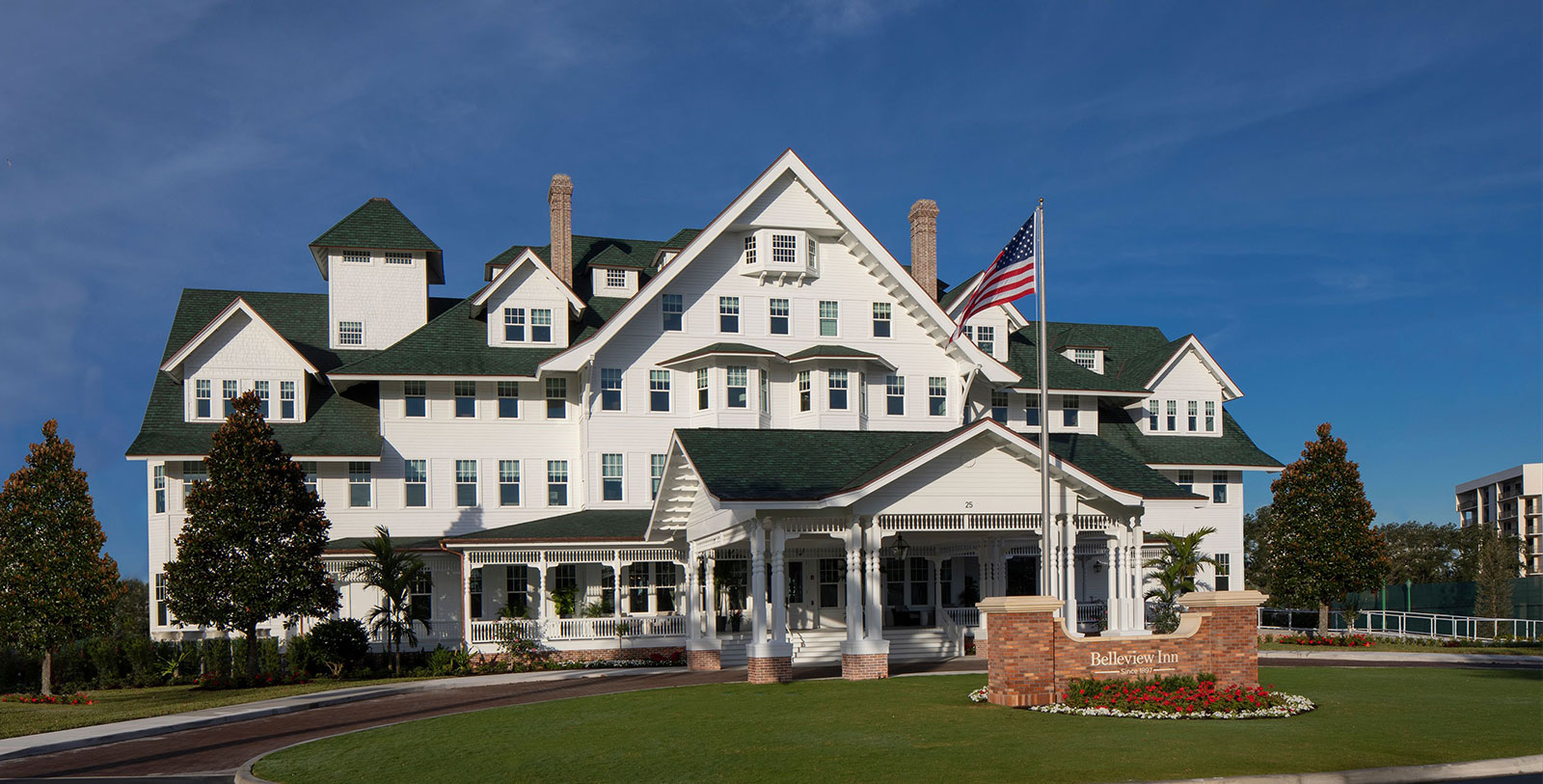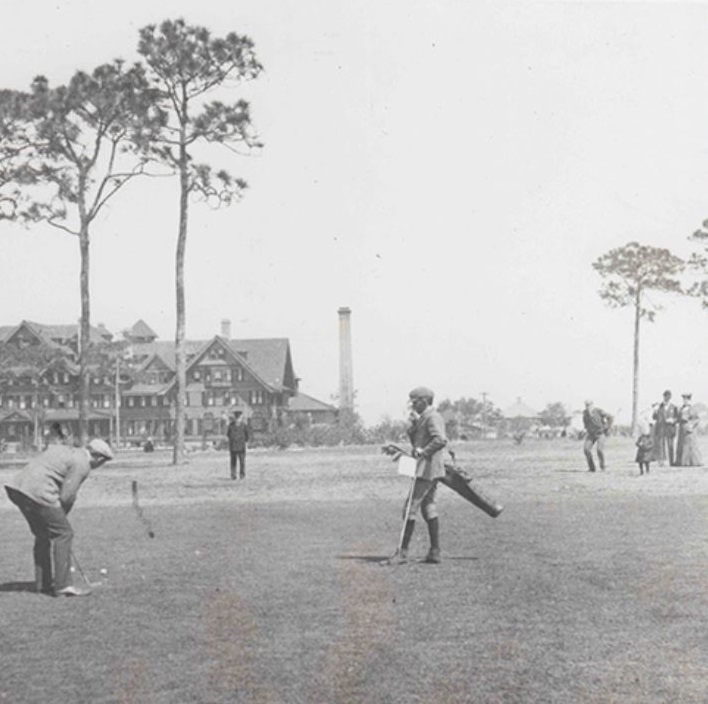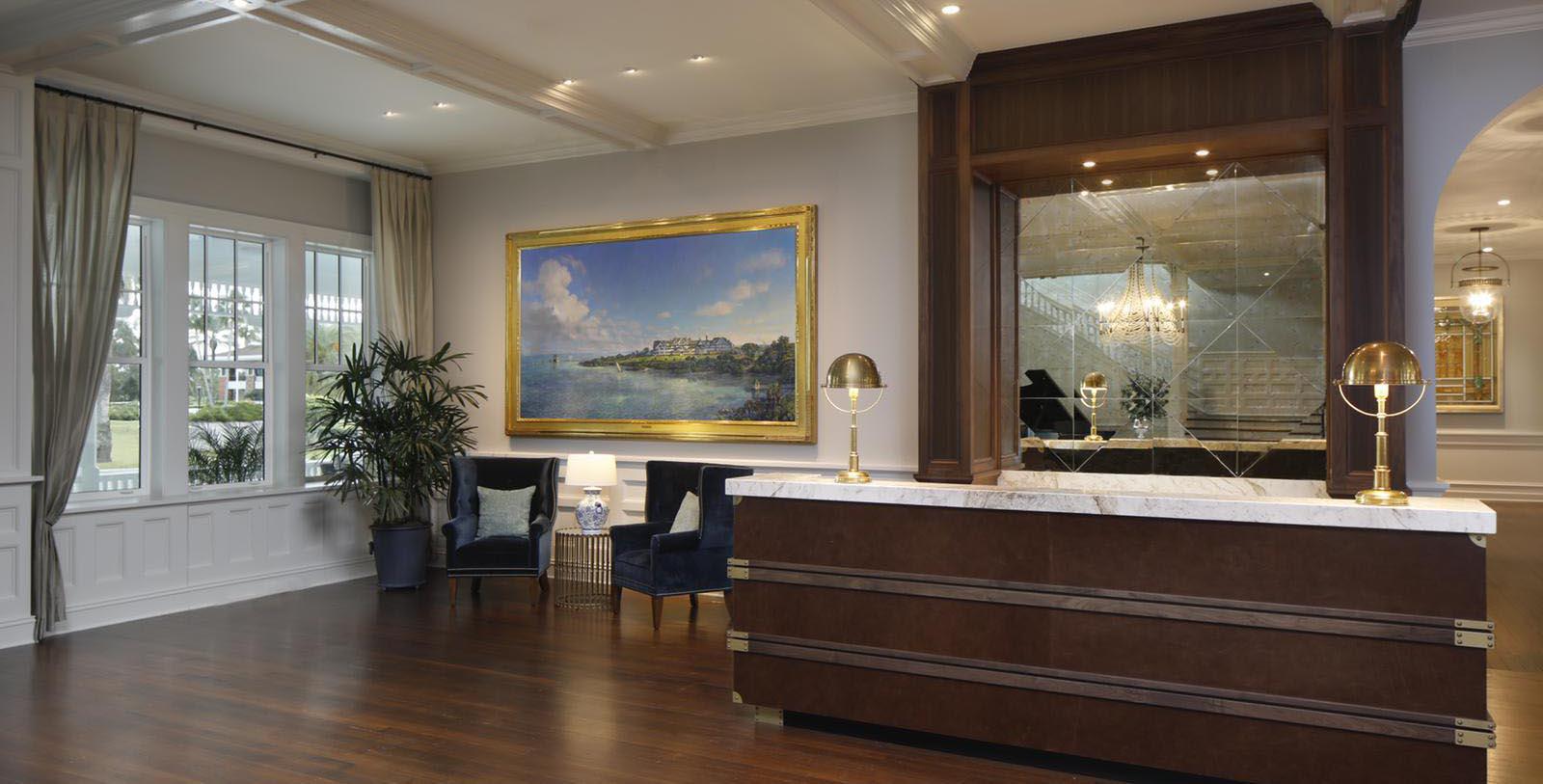Receive for Free - Discover & Explore eNewsletter monthly with advance notice of special offers, packages, and insider savings from 10% - 30% off Best Available Rates at selected hotels.
golf
Among the many fantastic activities available to guests staying at the Belleview Inn is access to the Belleair Country Club and its two elite golf courses—the West Course and the East Course. Located right beside the Belleview Inn, the Belleair Country Club is among Florida’s most historic golfing facilities. In fact, the histories of those two sites are deeply intertwined. Like the Belleview Inn, the Belleair Country Club dates to the twilight of the Gilded Age, when famed railroad magnate Henry B. Plant was busy extending his Orange Belt Railway across Florida. Seeking to make the railroad a popular tourist attraction, Plant subsequently developed his own resort hotel—the future Belleview Inn—along the line in 1897. But he also constructed numerous experiences around the destination to further augment the hotel’s appeal, including a quaint six-hole golf course next door. Featuring elevated greens made from crushed seashells, the course quickly became one of the inn’s most visited spots. Dozens of guests were soon walking its fairways regularly, prompting Plant’s son and successor—Morton F. Plant—to commission its abrupt expansion into the “Belleview Country Club.” (The senior Plant had passed away not long after the Belleview Inn’s debut.) Designed by Joseph J. Eldridge, the renovations took nearly two years to fully complete. Nevertheless, the course immediately resumed its status as one of Florida’s best golf courses when it reopened in 1899. Now measuring nine holes in length, Eldridge had masterfully upgraded all of the greens to feature smoothly rolling sand surfaces. Morton F. Plant himself assisted in the project as well, successfully implemented rich Indiana topsoil throughout all the fairways. Their hard work paid off wonderfully, as the revitalized golf course remained an attractive destination for golf enthusiasts. Plant instituted additional renovations to the course over the following years, which involved its enlargement to a full 18 holes in 1909. But in 1915, he decided to completely reconstruct the entire facility. Plant specifically hired the great Donald Ross to install another 18 holes, which were subsequently split into the West and East Courses, respectively. The golf courses subsequently remained a central fixture at the Belleview Inn for many decades thereafter, despite frequent changes in ownership. (The Belleview Country Club also rebranded as the “Belleair Country Club” around the same time, too, when the Plant family sold the neighboring Belleview Inn to the Bowman-Bitman Corporation after World War I.) Indeed, the courses hosted generations of golfers, including influential figures like Babe Ruth, Joe DiMaggio, and even two U.S. President—Gerald Ford and George H.W. Bush. But the West and East Courses also allured noted professional golfers occasionally, such as Bobby Jones and Walter Hagen. A few of those accomplished golfers—such as Alex Smith and Billy Burke—even served as the club pro for years. Both the West and East Courses exist today as part of the Belleair Country Club, which became a separate entity during the 1980s. Its private members have since ensured that its great historical character has endured perfectly intact. Perhaps the greatest testimony to this commitment was the massive restoration effort they undertook to comprehensively restore the West Course in time for its 125th anniversary. Guests residing at the Belleview Inn are still invited to experience the rich history that continues to define the West and East Courses. Cultural heritage travelers in particular are certain to enjoy trying the West Course’s fourth hole, as its par-three layout looks exactly the same from when it first opened more than a century ago.
Among the many fantastic activities available to guests staying at the Belleview Inn is access to the Belleair Country Club and its two elite golf courses—the West Course and the East Course. Located right beside the Belleview Inn, the Belleair Country Club is among Florida’s most historic golfing facilities. In fact, the histories of those two sites are deeply intertwined. Like the Belleview Inn, the Belleair Country Club dates to the twilight of the Gilded Age, when famed railroad magnate Henry B. Plant was busy extending his Orange Belt Railway across Florida. Seeking to make the railroad a popular tourist attraction, Plant subsequently developed his own resort hotel—the future Belleview Inn—along the line in 1897. But he also constructed numerous experiences around the destination to further augment the hotel’s appeal, including a quaint six-hole golf course next door. Featuring elevated greens made from crushed seashells, the course quickly became one of the inn’s most visited spots. Dozens of guests were soon walking its fairways regularly, prompting Plant’s son and successor—Morton F. Plant—to commission its abrupt expansion into the “Belleview Country Club.” (The senior Plant had passed away not long after the Belleview Inn’s debut.) Designed by Joseph J. Eldridge, the renovations took nearly two years to fully complete. Nevertheless, the course immediately resumed its status as one of Florida’s best when it reopened in 1899. Now measuring nine holes in length, Eldridge had masterfully upgraded all the greens to feature smoothly rolling sand surfaces. Morton F. Plant himself assisted in the project as well, successfully implementing rich Indiana topsoil throughout the fairways. Their hard work paid off wonderfully, as the revitalized golf course remained an attractive destination for golf enthusiasts for generations.
Plant instituted additional renovations to the course over the following years, which involved its enlargement to a full 18 holes in 1909. But in 1915, he decided to completely reconstruct the entire facility. Plant specifically hired the great Donald Ross to install another 18 holes, which were subsequently split into the West and East Courses. The golf courses subsequently remained a central fixture at the Belleview Inn for many decades thereafter, despite frequent changes in ownership. (The Belleview Country Club also rebranded as the “Belleair Country Club” around the same time, too, when the Plant family sold the neighboring Belleview Inn to the Bowman-Bitman Corporation after World War I.) Indeed, the courses hosted thousands of golfers, including influential figures like Babe Ruth, Joe DiMaggio, and even two U.S. President—Gerald Ford and George H.W. Bush. But the West and East Courses also allured noted professional golfers occasionally, such as Bobby Jones and Walter Hagen. A few of those accomplished golfers—such as Alex Smith and Billy Burke—even served as the club pro for years. Both the West and East Courses exist today as part of the Belleair Country Club, which became a separate entity during the 1980s. Its private members have since ensured its great historical character has remained perfectly intact. Perhaps the greatest testimony to this commitment was the massive restoration effort they undertook to comprehensively restore the West Course in time for its 125th anniversary. Guests residing at the Belleview Inn are still invited to experience the rich history that continues to define the West and East Courses. Cultural heritage travelers are certain to enjoy trying the West Course’s fourth hole, as its par-three layout looks the same as when it first opened more than a century ago.
-
About the Location +
Belleview Inn resides in the town of Belleair, itself being just a few miles down the road from the vibrant destination of Clearwater, Florida. Located specifically in the Pillenas Peninsula, the two settlements are among Florida’s most esteemed holiday destinations. But while both Belleair and Clearwater are currently famous for their identities as resort communities, their histories harken much farther back in time. Native Americans of the Tocobaga people once inhabited the region for millennia, purportedly using the clear mineral springs that spawned from the banks of what is now known as “Clearwater Bay.” (Clearwater Bay is the inlet between the main coastline and the thin strip of islands that proliferate further out into the Gulf of Mexico.) Yet, the first Europeans to arrive in the region were the Spanish, led by explorer Panfilo de Narvaez. While historians today speculate as to the exact location of Narvaez’s landing in 1528, most believe it was in the general vicinity of Clearwater and Belleair. He was then followed by the far-more famous Hernando de Soto a decade later, who first set foot on the other side of the peninsula in Tampa Bay. Passing by the region, Hernando de Soto eventually travelled through much of the American Southeast, before dying along the banks of the Mississippi River in 1542. Shortly after the founding of St. Augustine to the north in the 1560s, Pedro Menéndez de Avilés—the town’s administrator—sent a group of ten missionaries west to Pillenas Peninsula to create several missions. Those structures proved to be short-lived, as the Tocobaga and their allies destroyed them quickly. Human settlement throughout the area remained sparse by the early 19th century, save for a handful of isolated towns of Native Americans. But that all changed in 1822, when Florida formally became a part of the United States. Americans slowly moved to the area at first, until the Federal Armed Occupation Act of 1842 offered 140 acres to anyone interested. A population boom soon followed, with some of the region’s most prominent families constructing homesteads across the Pillenas Peninsula.
During the American Civil war, Clearwater Bay became a haven for rebel smugglers who frequently challenged the Union naval blockade out in the Gulf. In turn, gunboats affiliated with the U.S. Navy typically raided the coastline and even confiscated all kinds of supplies. But the Pillenas Peninsula remained free from large-scale fighting, only enduring economic hardships. When the war finally ended in the spring of 1865, Northerners moved to the peninsula and invested heavily into its economic development. Most hoped that a network railroad would incentivize travel into the state, transforming it into a popular vacation destination for those seeking a respite from the harsh winters of America’s Northeast and Midwest. The first railroad to arrive in the Pillenas Peninsula was the Orange Belt Railway, which Peter Demens—the founder of nearby St. Petersburg—created in 1888. The population swelled and several new towns quickly formed, including the likes of Clearwater some three years later. Railroad magnate Henry B. Plant took a particular interest in the area, buying the Orange Belt Railway in 1895. Recognizing the potential of the peninsula to become a luxurious retreat, he soon commissioned the development of a gorgeous boutique hotel along the railroad to further encourage its use. Completed some two years later as the “Belleview Hotel,” it rapidly became one of the most visited locations in the greater Tampa area. The town of Belleair itself manifested around Plant’s railroad, as people gathered to either work in the nascent hospitality industry or to build their own lavish seasonal homes. Nearly all the Pillenas Peninsula became a preeminent getaway by the dawn of the 20th century, with several thousand people visiting each year. Today, the region remains an amazing tourist hotspot, as many of its beaches continue to attract guests. In fact, Clearwater Beach has frequently been ranked as among the country’s best destinations year after year!
-
About the Architect +
Donald Ross: Few other golf course designers have had such an impact on the sport of golf than the legendary architect Donald Ross. Born in Dornoch, Scotland, Ross’ legendary career began when he apprenticed under Old Tom Morris at historic St. Andrews during the late 1890s. He harnessed several important skills from Morris that ranged from club maintenance to landscaping. Ross then used his education to parlay a job at the Royal Dornoch Golf Club near his childhood home. Unfortunately for Ross, the pay was abysmal. With the encouragement of Scottish expat named Robert W. Willson, Ross decided to try to find more rewarding work at one of the many new professional golf facilities that had started opening across the United States. Willson subsequently financed Ross’ trip across the Atlantic in 1899, who helped him settle down just outside of Boston, Massachusetts. Ross accepted a job as the resident golf pro at the Oakley Country Club, where he left an immediate impression upon its members. Word soon spread of his talents, which eventually attracted the attention of prominent businessperson James Walker Tufts. In the midst of developing the resort town “Pinehurst” within the North Carolina sandhills, Tufts decided to hire Ross to head the new settlement’s golf club. Ross headed south that winter, although not without some cajoling from friends who doubted the entire endeavor.
Nevertheless, Ross went to work in 1901, serving as the primary golf instructor for a single, 18-hole course created a few years prior by Dr. Leroy Culver and John Dunn Tucker. Ross decided to completely renovate its fairways after conferring with Tufts, thus jumpstarting the work on the future Pinehurst No(s). 1 – 4 over the next two decades. Over time, they quickly became the treasures that Tufts had originally envisioned. Their success further catapulted Ross’ reputation throughout the United States, inspiring many other destinations to hire him to design their respective courses. In all, Ross would create (and redesign) over 400 unique golf courses across the country, with some of his most notable being at the Seminole Golf Club, Oak Hill Country Club, and the Aronimink Golf Club. Ross was also commissioned to renovate the two golf courses that constitute the renowned Belleair Country Club in Florida. He subsequently transformed the layout into a stunning system of 18 different holes that blended in seamlessly into the surrounding countryside. Ross continued to work well into his seniority, often returning to Pinehurst to modify his first four professionally made courses. When he finally died in 1948, he had managed to leave a legacy that few others in the world of golf have come close to matching ever since. In fact, Ross’ legacy is still so great today that the World Golf Hall of Fame even inducted him posthumously several decades later in 1979.
-
Famous Historic Golfers +
Bobby Jones, winner of 13 golf championships that include the U.S. Open and the British Open.
Walter Hagen, winner of 11 major golf championships, including the U.S. Open, the British Open, and the PGA Championship.
Louise Suggs, winner of 11 major golf championships that include the Western Open, the Titleholders Championship, the Women’s PGA Championship, and the U.S. Women’s Open.
Walter Travis, winner of five major golf championships, including the U.S. Open and the British Open.
Gene Sarazen, winner of seven major golf championships that include the U.S. Open, the British Open, the PGA Championship, and the Masters Tournament.
Alex Smith, winner of two major golf championships—the 1906 and 1910 U.S. Opens.
Billy Burke, winner of one major golf championship—the 1935 U.S. Open.
Laurie Auchterlonie, winner of one major golf championship—the 1902 U.S. Open.
Fred McLeod, winner of one major golf championship—the 1908 U.S. Open.
Macdonald Smith, regarded by many as one of the best professional golfers, despite having never won a major title.
Babe Ruth, outfielder for the New York Yankees who is regarded as being the best baseball player in the sport’s history.
Joe DiMaggio, outfielder for the New York Yankees best remembered as the “Yankee Clipper.”
Gerald Ford, 38th President of the United States (1974 – 1977)
George H.W. Bush, 41st President of the United States (1989 – 1993)
-
Women in Golf +
Louise Suggs: One of the most renowned golfers to ever visit the Belleair Country Club was Louise Suggs. Enshrined in the World Golf Hall of Fame, Louise Suggs is credited today with founding the modern Ladies Professional Golf Association (LPGA). But her history in the sport harkens much further back to her youth when she first began winning competitions as a teenager. Her successes continued well into adulthood, winning three North and South Women’s Amateur titles. Furthermore, her early career saw victories at the U.S. Women’s Amateur, the Titleholders Championship, and the Women’s Western Open. After winning numerous tournaments, Suggs eventually formed the LPGA alongside 12 other colleagues for female golfers who wished to turn professional. Indeed, some of her cofounders were two of her biggest rivals at the time, Babe Zaharias and Patty Berg. Following its creation, Suggs became one of the organization’s greatest winners, acquiring the titles to several major championships. In addition to winning more Titleholders Championships and Women’s Western Opens, (which had now become a part of the LPGA’s main circuit), Suggs also won the U.S. Women’s Open and the Women’s PGA Championship. In fact, Suggs became the first professional female golfer to have a career grand slam, following her victory in the 1957 Women’s PGA Championship. In honor of her renowned accomplishments, Suggs was inducted into the World Golf Hall of Fame in 1951.




































